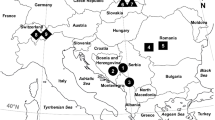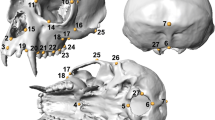Abstract
Allometric and heterochronic approaches to sexual dimorphism have contributed much to our understanding of the evolutionary morphology of the primate skull and dentition. To date, however, extensive studies of sexual dimorphism have been carried out only on the great apes and a few cercopithecine monkeys. To fill this gap, representative dimensions of the skull were collected among ontogenetic series of two dimorphic Old World monkeys:Macaca fascicularis (Cercopithecinae) andNasalis larvatus (Colobinae). The ontogeny of cranial sexual dimorphism was evaluated with least-squares bivariate regression, analysis of covariance (ANCOVA), and analysis of variance (ANOVA). Results indicate that within each species the sexes typically exhibit nonsignificant differences in ANCOVAs of ontogenetic trajectories, except for bivariate comparisons with bicanine breadth. AmongMacaca fascicularis, ANOVAs between males and females of common dental ages show that adult, and frequently subadult, males are significantly larger than females, i.e., sexual dimorphism develops via time and rate hypermorphosis (males primarily grow for a longer time period as well as faster). AmongNasalis larvatus, however, comparisons between males and females of common dental ages indicate that only adult males are significantly larger than females, i.e., sexual dimorphism develops primarily via time hypermorphosis (males grow for a longer time period). Within both species, females appear to exhibit an early growth spurt at dental age 2; that is, many cranial measures for females tend to be larger than those for males. Measures of the circumorbital region (e.g., browridge height), body weight, and bicanine breadth exhibit typically the highest sexual dimorphism ratios. The fact that postcanine toothrow length and neurocranial volume (less so inNasalis) demonstrate very low dimorphism ratios generally supports assertions that postnatal systemic growth (and associated selective pressures thereon) exerts a greater influence on facial, but not neural, dental, or orbital, development (Cochard, 1985, 1987; Shea, 1985a,b, 1986; Shea and Gomez, 1988; Sheaet al., 1990). Additional consideration of ontogenetic differences between species generally supports previous functional interpretations of subfamilial differences in cranial form related to agonistic displays in cercopithecine monkeys (Ravosa, 1990).
Similar content being viewed by others
References
Cheverud, J. M., and Richtsmeier, J. T. (1986). Finite-element scaling applied to sexual dimorphism in rhesus macaque (Macaca mulatta) facial growth.Syst. Zool. 35: 381–399.
Cochard, L. R. (1985). Ontogenetic allometry of the skull and dentition of the rhesus monkey (Macaca mulatta). In Jungers, W. L. (ed.),Size and Scaling in Primate Biology, Plenum Press, New York, pp. 231–256.
Cochard, L. R. (1987). Postcanine tooth size in female primates.Am. J. Phys. Anthropol. 74: 47–54.
Cole, T. M. (1990). Sexual dimorphism of hyoid growth and cranial form inAlouatta seniculus.Am. J. Phys. Anthropol. 81: 206.
Dechow, P. C., and Carlson, D. S. (1990). Occlusal force and craniofacial biomechanics during growth in rhesus monkeys.Am. J. Phys. Anthropol. 83: 219–238.
Freedman, L. (1962). Growth of muzzle length relative to calvaria length inPapio.Growth 162: 117–128.
Hays, R. W. (1990). A comparison of growth and sexual dimorphism in patas monkeys (Erythrocebus patas) and African green monkeys (Cercopithecus aethiops).Am. J. Phys. Anthropol. 81: 238.
Jarman, P. (1983). Mating system and sexual dimorphism in large, terrestrial, mammalian herbivores.Biol. Rev. 58: 485–520.
Kay, R. F. (1975). Functional adaptations of primate molar teeth.Am. J. Phys. Anthropol. 43: 195–216.
Kay, R. F., and Cartmill, M. (1977). Cranial morphology and adaptations ofPalaechthon nacimienti and other Paromomyidae (Plesiadapoidea, ?Primates), with a description of a new genus and species.J. Hum. Evol. 6: 19–35.
Leigh, S. R., and Cheverud, J. M. (1991). Sexual dimorphism in the baboon facial skull.Am. J. Phys. Anthropol. 84: 193–208.
Leutenegger, W., and Masterson, T. J. (1989a). The ontogeny of sexual dimorphism in the cranium of Bornean orang-utans (Pongo pygmaeus pygmaeus). I. Univariate analyses.Z. Morphol. Anthropol. 78: 1–14.
Leutenegger, W., and Masterson, T. J. (1989b). The ontogeny of sexual dimorphism in the cranium of Bornean orang-utans (Pongo pygmaeus pygmaeus). II. Allometry and heterochrony.Z. Morphol. Anthropol. 78: 15–24.
Masterson, T. J., and Leutenegger, W. (1990). The ontogeny of sexual dimorphism in the cranium of Bornean orang-utans (Pongo pygmaeus pygmaeus) as detected by principal components analysis.Int. J. Primatol. 11: 517–539.
Oxnard, C. E. (1983). Sexual dimorphisms in the overall proportions of primates.Am. J. Primatol. 4: 1–22.
Plavcan J. M. (1990).Sexual Dimorphism in the Dentition of Extant Anthropoid Primates, Ph.D. thesis, Duke University, Durham, NC.
Ralls, K. (1977). Sexual dimorphism in mammals: Avain models and unanswered questions.Am. Nat. 111: 917–938.
Ravosa, M. J. (1989).An Evaluation of Biomechanical and Non-Mechanical Models of Primate Circumorbital Morphology, Ph.D. thesis, Northwestern University, Evanston, IL.
Ravosa, M. J. (1990). A functional assessment of subfamily variation in maxillomandibular morphology among Old World monkeys.Am. J. Phys. Anthropol. 82: 199–212.
Ravosa, M. J. (1991). Ontogenetic perspective on mechanical and non-mechanical models of primate circumorbital morphology.Am. J. Phys. Anthropol. 85: 95–112.
Ravosa, M. J., and Ross, C. F. (in preparation). Craniofacial allometry and heterochrony in two howler monkeys:Alouatta seniculus andA. palliata.
Richtsmeier, J. T., and Cheverud, J. M. (1989). Sexual dimorphism of facial growth inMacaca mulatta andM. fascicularis.Forts. Zool. 35: 438–440.
Schultz, A. H. (1940). The size of the orbit and eye in primates.Am. J. Phys. Anthropol. 26: 389–408.
Shea, B. T. (1985a). The ontogeny of sexual dimorphism in the African apes.Am. J. Primatol. 8: 183–188.
Shea, B. T. (1985b). Ontogenetic allometry and scaling: A discussion based on the growth and form of the skull in African apes. In Jungers, W. L. (ed.),Size and Scaling in Primate Biology, Plenum Press, New York, pp. 175–205.
Shea, B. T. (1986). Ontogenetic approaches to sexual dimorphism in anthropoids.Hum. Evol. 1: 97–110.
Shea, B. T. (1988). Heterochrony in primates. In McKinney, M. L. (ed.),Heterochrony in Evolution, Plenum Press, New York, pp. 237–266.
Shea, B. T., and Gomez, A. M. (1988). Tooth scaling and evolutionary dwarfism: An investigation of allometry in human pygmies.Am. J. Phys. Anthropol. 77: 117–132.
Shea, B. T., Hammer, R. E., Brinster, R. L., and Ravosa, M. J. (1990). Relative growth of the skull and postcranium in giant transgenic mice.Genet. Res. 56: 21–34.
Swindler, D. R., Sirianni, J. E., and Tarrant, L. H. (1973). A longitudinal study of cephalofacial growth inPapio cynocephalus andMacaca nemestrina.Symp. IVth Int. Congr. Primatol. 3: 227–240.
Todd, T. W., Beecher, H., Williams, G. H., and Todd, A. W. (1940). The weight and growth of the human eyeball.Hum. Biol. 12: 1–20.
van Schaik, C. P., Ijsseldijk, A. T. H. J., and de Ruiter, J. R. (1991). Sex differences in growth and development of long-tailed macaques (Macaca fascicularis): The effect of food supply (submitted for publication).
Wiley, R. H. (1974). Evolution of social organization and life-history patterns among grouse.Q. Rev. Biol. 49: 201–227.
Author information
Authors and Affiliations
Rights and permissions
About this article
Cite this article
Ravosa, M.J. The ontogeny of cranial sexual dimorphism in two old world monkeys:Macaca fascicularis (Cercopithecinae) andNasalis larvatus (Colobinae). International Journal of Primatology 12, 403–426 (1991). https://doi.org/10.1007/BF02547620
Received:
Revised:
Issue Date:
DOI: https://doi.org/10.1007/BF02547620




